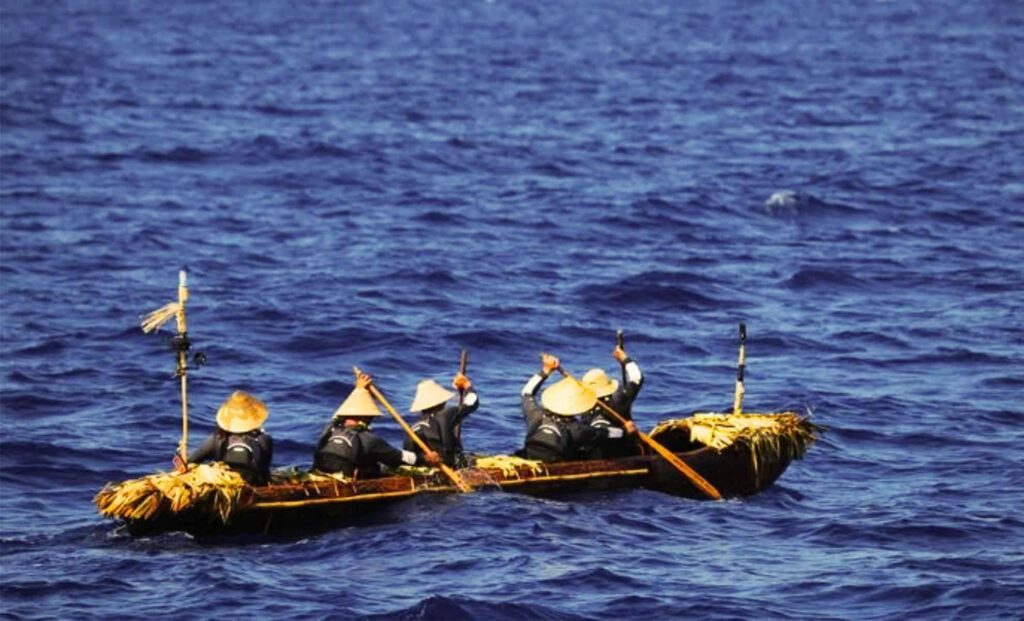
In the dense forests of eastern Taiwan, a team of intrepid scientists embarked on a journey to solve a mystery that has long intrigued archaeologists: How did Paleolithic humans manage to traverse the vast ocean to reach the remote islands of southern Japan without the aid of modern technology? This ambitious endeavor aimed to recreate a voyage that dates back 30,000 years, bridging a significant chapter of human history.
Under the leadership of Professor Yousuke Kaifu from the University of Tokyo, researchers from Japan and Taiwan embarked on a remarkable expedition. They set sail from eastern Taiwan to Japan’s Yonaguni Island, covering approximately 225 kilometers across open waters. To maintain historical accuracy, the team utilized a 7.5-meter dugout canoe, crafted using replicas of ancient stone tools.
Ancient Technology Meets Modern Science
The construction of the canoe, named Sugime, began in 2019. It was carved from a single Japanese cedar log, felled with a reconstructed Paleolithic axe, and hollowed out by hand in a public exhibition at Tokyo’s National Museum of Nature and Science. Kunihiro Amemiya, a craftsman involved in the project, donned handmade animal hide clothing and demonstrated traditional woodworking techniques throughout the process.
Actress Hikari Mitsushima, originally from Okinawa Prefecture, participated in the carving demonstration, highlighting the symbolic nature of the effort. “As the trunk is hollowed out bit by bit, it’s like the memories of those making it are being left behind,” she remarked. The canoe was designed to withstand the challenges of an open sea crossing, meeting the specifications required for such a voyage.
Carpenter Kunihiro Amemiya hollows out a log to make a dugout canoe using a reconstructed stone axe from the Japanese Paleolithic period as part of a project to reproduce the voyage to the Japanese archipelago 30,000 years ago, at the entrance to the National Museum of Nature and Science in Tokyo’s Taito Ward, on July 31, 2018. Credit: Mainichi Japan
Across the Sea on Instinct Alone
In 2025, the research team launched Sugime into the East China Sea, aiming to replicate the presumed migration route of early humans. The journey took over 45 hours, during which they navigated without maps or modern devices, relying solely on natural indicators like the sun, stars, and ocean swells.
Their destination, Yonaguni Island in Japan’s Ryukyu Archipelago, was reached successfully despite minimal visibility of land throughout the crossing. “We now know that these canoes are fast and durable enough to make the crossing,” said Kaifu. “But that’s only half the story. Those male and female pioneers must have all been experienced paddlers with effective strategies and a strong will to explore the unknown.”
Credit: Mainichi Japan
Simulations Unlock Ancient Strategies
To complement the physical experiment, the team conducted numerous virtual simulations, incorporating ancient ocean conditions and testing various departure points, seasons, and paddling strategies. These simulations revealed that departing from northern Taiwan increased the likelihood of a successful crossing.
A significant finding was the necessity of angling slightly southeast rather than heading directly toward the destination. This strategy helped counter the Kuroshio Current, one of the world’s most powerful oceanic flows. “I thought if you entered it, you could only drift aimlessly,” said Dr. Yu-Lin K. Chang, an oceanographer at JAMSTEC. “But the results of our simulations went far beyond what I had imagined.”
Rethinking Early Human Exploration
The experiments lend support to the hypothesis that early modern humans could have migrated to the Japanese archipelago using canoes. Traditional archaeological evidence, such as artifacts and skeletal remains, has proven insufficient due to the ocean’s tendency to erase physical traces. This led the research team to employ experimental archaeology to fill in these gaps.
Professor Kaifu emphasized the parallels between Paleolithic migration and later seafaring cultures. “For example, the ancient Polynesian people had no maps, but they could travel almost the entire Pacific,” he noted. “There are a variety of signs on the ocean to know the right direction, such as visible land masses, heavenly bodies, swells, and winds. We learned parts of such techniques ourselves along the way.”
The successful recreation of this ancient journey not only sheds light on the capabilities of early humans but also inspires a deeper appreciation for the ingenuity and resilience of our ancestors. As the scientific community continues to explore the rich tapestry of human history, such experiments offer invaluable insights into the skills and strategies that shaped early human exploration.







